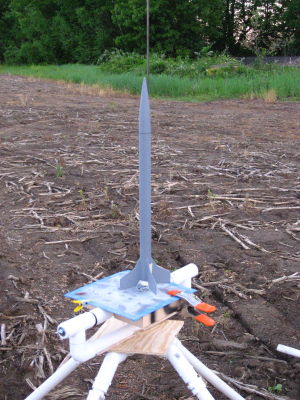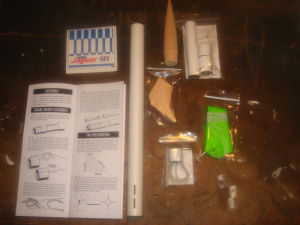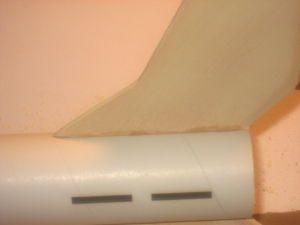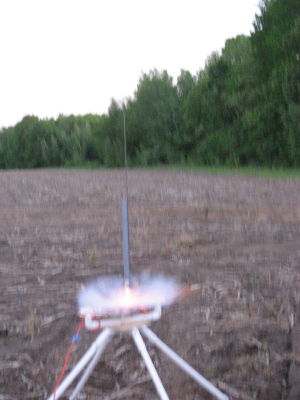| Construction Rating: | starstarstarstarstar |
| Flight Rating: | starstarstarstarstar_border |
| Overall Rating: | starstarstarstarstar |
| Manufacturer: | Semroc  |

Brief:
This is a relatively easy model 4FNC kit for entering mid-power rockets. The quality of the components was high and
instructions were top notch. This kit was my first foray into anything larger than 18mm engines, and it was a perfect
start. I was initially a little skeptical of my abilities but found the kit so intuitive I barely needed the
instructions. It's listed as a Skill Level 3, but I initially felt it's more of a 2. After launching it, I'm not so
sure...
Construction:
The components in the kit included:
- Body tube
- Balsa nose cone (6" long)
- Basswood fins in their own baggie
- A baggie with a thrust ring, launch lug, screw eye, elastic cord, Kevlar® thread
- Nylon parachute, pre assembled in its own baggie
- Engine mount kit, in its own baggie:
- 2 center rings
- Thrust ring
- E-engine hook
- Engine tube
- Spacer tube

The first thing I noticed when I opened the kit bag was how thick the body tube was, yet still very light. As mentioned in the previous review, all the components came in separate bags.
The 4 fins were made of basswood and were incredibly easy to work with. The (huge) nosecone was balsa, well balanced, symmetrical, and required very little attention aside from sealing. The shock cord assembly seemed plenty long enough, and this was my first kit that included a rip-stop nylon chute that was already assembled. The kit also included a heavy-duty screw-eye for the chute, a 29mm-24mm adapter, and the various rings and tubes necessary.
The instructions will refer the builder to the bags as they become necessary. Each bag includes a separate itemized list of components, an attention to detail that I had not noted in other kits I've built. Further, the instructions were detailed but not over the top and the illustrations were quite large.
After noting the quality components, I then noticed the quality of the instructions, which were in multi-page pamphlet form and stapled down the middle of the fold. The font was large and very easy to follow, and the illustrations were huge compared to other kits I've built. Last, there was a parts list with an "exploded view" that wasn't necessary but still a nice touch.
Assembly is logical and straightforward. The 29mm-24mm adapter is assembled first. The baggie with the components for the adapter comes with its own set of instructions. There is an assumption that if you're buying this mid-power rocket that it's not the first kit you've built. The "subcomponents" weren't itemized on the "exploded view". By use of a spacer, the adapter assembly allows the flyer to use both 24mm x 70mm engines (Estes D and E) as well as longer 24mm x 95mm engines.
After the adapter, you prepare the shock cord and thrust ring, which is inserted using the adapter as a guide. From there you work on the fins, fillets, nosecone, and chute. There are no couplers to contend with, which is a good thing because I very nearly ruined my Apogee Aspire when the coupler bound as I inserted it into the tube. I don't like couplers very much right now.
 There is a recommendation to sand the fins and round the leading edges as well as taper the trailing
edges. This led to the one "gotcha" which is more the result of my being relatively new than to poor
instructions: there was no warning about over sanding the fins and loosening the fit into the groves in the body tube.
When I did the rounding and tapering, I over-sanded one fin and it required extra glue and epoxy to make it fit well.
There is a recommendation to sand the fins and round the leading edges as well as taper the trailing
edges. This led to the one "gotcha" which is more the result of my being relatively new than to poor
instructions: there was no warning about over sanding the fins and loosening the fit into the groves in the body tube.
When I did the rounding and tapering, I over-sanded one fin and it required extra glue and epoxy to make it fit well.
Another mistake involved sealing the fins prior to attaching them (a diversion from the instructions), figuring it would be easier to seal and sand with them off. I used paper skins on all my previous kits, making sealing unnecessary. As mentioned above, I over-sanded one fin and it was too narrow, making a loose fit.
The fins had a very snug fit and the through the wall construction didn't require significant adjustments to make them perfectly perpendicular to the tube.
Aside from using 5-minute epoxy for the fillets and smearing a very thin layer on the inside of the body tube on the roots of the fins, which helped make the adapter very snug, I didn't do any mods. I considered cutting a section as a payload bay, but didn't want to make extra work. I'll do this later when I get my altimeter.
The Kevlar® cord is long enough to extend beyond the end of the body tube. I built this rocket according to the instructions, however, I am concerned about zippering. I may shorten it prior to flight.
The nosecone was very snug and required a little sanding. Caution: a little sanding goes a long way. In very little time I made it a bit too loose and will likely use masking tape to make it more snug.
It's not mentioned in the instructions, but I used a quick link to attach the parachute. I bought these at my local sporting goods store.
Finishing:
Preparing for finishing was easy. As I mentioned above, I sealed the fins prior to attaching them. I would do this
again in the future but will be aware about over-sanding.
The fins and nosecone required only one coat of sealer, although it was a thick consistency.
I did not try to fill the spirals. They seemed pretty shallow and the primer I use is thicker than most and will fill in groves pretty well. Though I suspected that after a few coats of paint, the groves would all but disappear, they are still visible after 3 coats of primer.
I haven't figured out a color scheme yet, but will likely follow the scheme on the picture. I'll wait until I have other rockets to paint before doing the final coats.
Construction Rating: 5 out of 5

Flight:
Flight preparation: The diameter of the rocket is large enough that several pieces of wadding will be necessary,
likely 4 or 5 pieces (I tend to do overkill since I've singed too many recovery devices in the past few weeks).
Flight with the adapter: Motor retention includes an engine hook. The adapter unit itself will need to be taped in to prevent it from shooting out during ejection. The thin layer of epoxy I put on the inside of the body tube made the adapter a very tight fit. It will require retention (friction and tape around the bottom), but I don't think there will be a need for any "adjunctive" retention (I lost 2 rockets recently, so don't rely on friction fitting by itself any more. Keep an eye out for some tips regarding "adjunctive" retention).
Flight with 29mm engines: This is a minimum diameter rocket for 29mm engines, so friction fitting is required. If you read my launch logs, you'll see that I recently haven't had luck with friction fitting, so I'm leery of using 29mm engines for now.
This rocket requires a 3/16inch launch rod. I didn't have one yet so the cost was 3.50 or so at my local big box home improvement store. No big deal.
I have a bunch of Estes D12s, which was one of the reasons I bought this rocket. I completed the rocket on a Friday evening. Saturday was too breezy, launch scrubbed. Sunday, launch scrubbed. Monday, holiday--all-day grill-fest, launch scrubbed (too windy anyway). Tuesday, thunderstorms, launch scrubbed (there was a 1hr period of sun and absolutely no wind, but I didn't move fast enough). Wednesday, breezy, took my launch gear to work in case there was an opportunity for a "lunch launch". No such luck.
At last! Wednesday at early dusk, the wind died to a near standstill. Finally! All I needed was 30 minutes of calm weather.
I clipped on the quick link/chute (I don't store the chute in the rocket), and used 4 pieces of wadding. In narrower rockets I've feared that I made them too tight, but they went in this rocket loosely enough. Folded up the chute, put in a D12-7 (sims to 1200 feet) and went to town.
Uh-oh. Here's where my inexperience kicks in: I'm a "born again rocketeer", built many kits, but am only 2 months in to this new found hobby. The root edge of the fins are flush with the base of the rocket. There's no place to wrap tape. Instead, I put pieces between the fins and extended them down onto the adapter. I then used a piece of tape around the part of the adapter that sticks out to hold the other pieces on. I couldn't friction fit the adapter on, it was too tight even for a single layer of masking tape.
I didn't feel good about this, as I mentioned above I don't have a good success rate with taped on engines/adapters. But I was so psyched to launch this rocket. So to the field I went.
Even though it was only primed, it looked really cool on the pad. In fact, I considered leaving it primed, but sanding it smooth and coating it with clearcoat.
My St. Bernard/Golden Retriever mix, Mattie, was by my side as my buddy and I did the count down. We scrubbed the first attempt because Mattie thought she should start chasing down the rocket early and dislodged the igniter.
Mattie was put in the car so the second attempt went without a hitch. My system uses a 12-volt lawn tractor battery so there is little, if any, delay. The engine hissed for a millisecond, there was a burst of smoke, a medium-fast lift-off, and then a straight, beautiful launch. I'm 40 and can't help but get a rush out of this. I'd guess it reached 1000 feet or more (primer wasn't even sanded smooth yet so it probably didn't go the full 1200.
Recovery:
The 7 second delay seemed to last forever. Finally the smoke trail started, and I heard a faint pop and saw the trail
stop. I saw a separation and then went to get my dog, who was barking like she was hallucinating about a huge rawhide
(or maybe a rabbit or maybe even the St. Bernard Pass itself) sitting in middle of the field.
I turned back to my rocket and it was gone. I couldn't find it. My buddy said he lost it also.
I have no idea what happened. Dusk was coming in quickly, but we combed a large area. I'll go back tomorrow to look around and also drive around the neighboring neighborhood. I'm incredibly disappointed. I recently bought a Transolve Micro Trans Beep but didn't use it. I could kick myself, as maybe this would have helped. I felt really confident about this launch. The body tube was plenty roomy so nothing could jam, I still feel the adapter wasn't going anywhere... I have no idea what happened.
I'm not sure how to score the Flight/Recovery as the loss is likely my fault. However, it would be nice if manufacturers could figure out a way to avoid friction fits. I have a few ideas I've been playing with, keep an eye out in the tips section. I'll give this a 4. There could be some improvement (more room for tape?), but it's likely the loss was my fault.
Flight Rating: 4 out of 5
Summary:
The main pro for this rocket is that it has an easy, logical, intuitive (hmmm, if it's logical, isn't it
automatically intuitive?) assembly process. Assembly didn't take any longer than any other rocket.
The rocket is very versatile as it uses 70mm and 95mm 24mm engines as well as 29mm engines.
The only con is that it is easy to over-sand the root side of the fins.
Overall Rating: 5 out of 5
Other Reviews
- Semroc SLS Jaguar By Ben Shetler
Brief: The Semroc SLS Jaguar is a fairly simple 4FNC single stage rocket with 24mm or 29mm motor mount options and parachute recovery. Construction: The kit includes the following components: 1 SLS series body tube 1 balsa nose cone 4 laser cut basswood fins 1 thrust ring 1 3/16" launch lug 1 screw eye 1 elastic shock cord 1 Kevlar ® thread ...
 |
 |
Flights
 |
 |